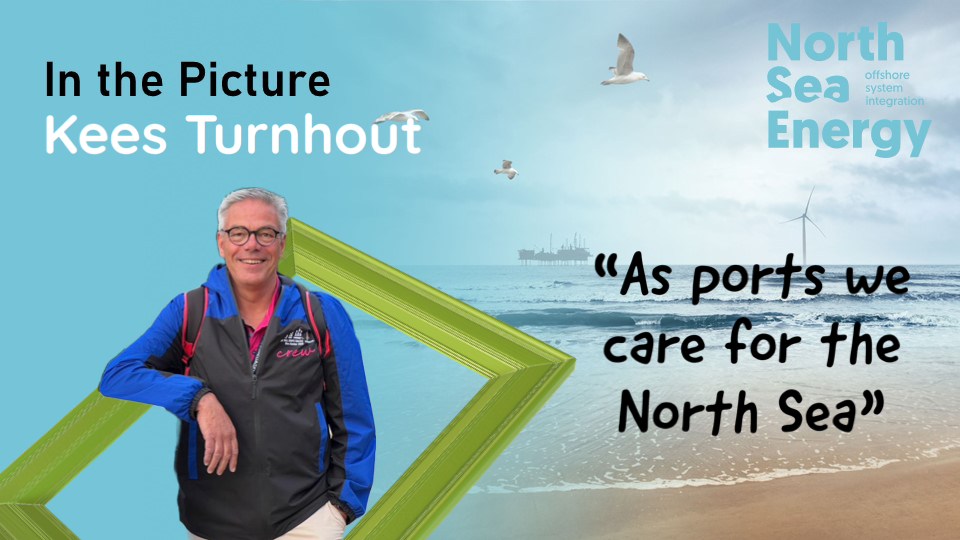NSE Partner in the Picture – Kees Turnhout
March 19, 2024
Kees Turnhout, Port of Den Helder
To enhance the participatory process, we interview NSE participants, representatives from politics, policy and administration, and stakeholders from the sector to share their vision on the role of the North Sea in the energy transition and the opportunities and challenges they see for system integration. In this interview Kees Turnhout from Port of Den Helder reflects on the role of the Hydroports in the offshore energy transition.
Kees, could you share with us your personal journey within Port of Den Helder (PoDH) and your upcoming role as the new CEO?
Kees: “Absolutely. Within PoDH, my focus has been on port infrastructure and technology. All ports are now in a process of development, that has its roots in the energy transition. I began this journey alongside Jacoba Bolderheij, shaping the vision for the Den Helder Port Authority. As Jacoba embarks on new challenges, I'm honoured to step into the role of CEO from April 1st.”
Let's look at the Hydroports, a partnership between PoDH, Groningen Seaports and the Port of Amsterdam. Under this heading the three ports are partner in the NSE program. Could you elaborate on Hydroport's mission and the collaboration between these ports? What ties you together?
Kees: The Hydroport cooperation emerged from a study in 2021, initiated by Catrinus Jepma of the New Energy Coalition. It's a collaborative effort between the three northerly ports, exploring synergies in energy infrastructure and system integration at sea. Each port plays a crucial role in facilitating the landing of offshore energy, transitioning from oil and gas to current and future ventures like wind power and hydrogen. Den Helder, with its strategic location and potential grid connections complements Amsterdam's industrial demand for sustainable energy. Amsterdam’s and Den Helder’s partnership with NSE began in the former phase of the program; it now extends into the current phase under the Hydroport umbrella together with Groningen Seaports.”
The energy transition is a pressing global issue. What initiatives are you undertaking collectively to drive this transition forward, particularly concerning offshore system integration?
Kees: “Our collaboration is symbiotic. Amsterdam boasts industrial demand; Den Helder offers space and strategic positioning. Together with Groningen Seaports, we form a cohesive energy infrastructure network, facilitating local and regional industries transitioning from fossil fuels and stockpiles to renewable energy supply. Our expertise in servicing the oil and gas sector equips us to lead in sustainable energy solutions. Furthermore, we're committed to reducing emissions within our own port activities to zero, aligning with the broader goals of the energy transition.”
Becoming NSE partners underpins a commitment to shaping the future of energy. What drove this decision, and how important is the NSE research work to future decisions regarding offshore energy systems?
Kees: “NSE's focus on offshore hydrogen production aligns with our vision for sustainable energy supply. Projects such as H2Gateway (led by NAM), aimed at blue hydrogen production with carbon capture and storage, present exciting opportunities for integration of functions. NSE's integrated approach to offshore energy systems allows us to contribute expertise, especially in the onshore landing of offshore produced energy and offshore logistics. Looking at the offshore energy challenge from multiple perspectives, stakeholder views and ecological inclusiveness is where we see the value of NSE. We appreciate the program for including environmental sustainability and safety as part of the research work. We bring a long history and knowledge. As gateways to offshore energy, we can add value. Our ports play a pivotal role in ensuring a smooth transition to renewable energy sources while taking care of the North Sea.”
Could you shed some light on the specific work packages your ports are involved in, and why collaboration is paramount in this endeavour?
Kees: I work closely with Jan Egbertsen from Port of Amsterdam and Jannes Stokroos from Groningen Seaports. Next to our role in the steering committee, we are closely involved in work packages 1 and 6, respectively focusing on energy hubs and logistics. Furthermore my colleague Katja Naber supports the communication around NSE. By pooling our resources and expertise, we're better equipped to address the multifaceted challenges of the energy transition. Collaboration fosters innovation, efficiency, and ultimately, a more sustainable future for generations to come.
In conclusion, Kees's insights highlight the pivotal role of collaboration and innovation in shaping the future of energy. As these ports embark on their journey towards a sustainable energy future, their collective efforts promise to revolutionize the global energy landscape.
